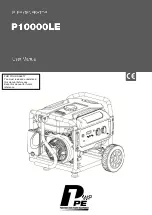
SIEPCYEUOQ2V01A Q2V Technical Manual
631
12.8
L: PROTECTION
L parameters
set the following functions.
•
Motor Overload Protection
•
Operation During Momentary Power Loss
•
Stall Prevention
•
Speed Detection
•
Auto Restart
•
Detection of Overtorque/Undertorque
•
Torque Limit
•
Hardware Protection
◆
L1: MOTOR PROTECTION
L1 parameters
set the motor overload protection function.
■
Motor Protection Using Positive Temperature Coefficient (PTC) Thermistors
The temperature resistance characteristics of three PTC thermistors in the motor stator winding protect the motor
from overheat.
A PLC thermistor must have the characteristics shown below for each motor phase.
Figure 12.106 PTC Thermistor Temperature and Resistance
If the PTC input signal input to the drive is more than the overload alarm level, the drive detects
oH3 [Motor
Overheat (PTC Input)]
. The drive continues the operation set in
L1-03 [Motor oH AL Reaction Select]
. By
default, the keypad shows oH3 and the drive continues operation.
The overheat fault level triggers an
oH4 [Motor Overheat Fault (PTC Input)]
fault, and outputs a fault signal. The
drive outputs a fault signal and uses the stop method set in
L1-04 [Motor oH FLT Reaction Select]
to stop the
motor.
Note:
PTC is an acronym for Positive Temperature Coefficient.
■
L1-01: Motor Cool Type for OL1 Calc
No.
(Hex.)
Name
Description
Default
(Range)
L1-01
(0480)
Motor Cool Type for OL1
Calc
Sets the motor overload protection with electronic thermal protectors.
Determined by A1-02
(0 - 6)
This parameter enables and disables the motor overload protection with electronic thermal protectors.
The cooling capability of the motor changes when the speed control range of the motor changes. Use an electronic
thermal protector that aligns with the permitted load characteristics of the motor to select motor protection.
The electronic thermal protector of the drive uses these items to calculate motor overload tolerance and supply
overload protection for the motor:
•
Output Current
•
Output Frequency
V/f
OLV
OLV/PM
OLV/PM AOLV/PM
EZOLV
Summary of Contents for Q2V Series
Page 2: ...This Page Intentionally Blank 2 SIEPCYEUOQ2V01A Q2V Technical Manual...
Page 12: ...12 SIEPCYEUOQ2V01A Q2V Technical Manual...
Page 18: ...i 2 Legal Information 18 SIEPCYEUOQ2V01A Q2V Technical Manual...
Page 26: ...1 2 Features and Advantages of Control Methods 26 SIEPCYEUOQ2V01A Q2V Technical Manual...
Page 38: ...2 8 Installation Methods 38 SIEPCYEUOQ2V01A Q2V Technical Manual...
Page 70: ...3 3 Main Circuit Wiring 70 SIEPCYEUOQ2V01A Q2V Technical Manual Models B006 B012...
Page 102: ...3 17 Motor Application Precautions 102 SIEPCYEUOQ2V01A Q2V Technical Manual...
Page 138: ...4 12 Test Run Checklist 138 SIEPCYEUOQ2V01A Q2V Technical Manual...
Page 144: ...5 2 European Standards 144 SIEPCYEUOQ2V01A Q2V Technical Manual...
Page 145: ...Standards Compliance 5 5 2 European Standards SIEPCYEUOQ2V01A Q2V Technical Manual 145...
Page 146: ...5 2 European Standards 146 SIEPCYEUOQ2V01A Q2V Technical Manual...
Page 266: ...7 10 Troubleshooting Without Fault Display 266 SIEPCYEUOQ2V01A Q2V Technical Manual...
Page 284: ...8 6 Storage Guidelines 284 SIEPCYEUOQ2V01A Q2V Technical Manual...
Page 312: ...10 10 Peripheral Devices and Options 312 SIEPCYEUOQ2V01A Q2V Technical Manual...
Page 430: ...11 21 Parameters Changed by PM Motor Code Selection 430 SIEPCYEUOQ2V01A Q2V Technical Manual...
Page 731: ...SIEPCYEUOQ2V01A Q2V Technical Manual 731 Z Z pulse Auto Tuning 125...















































